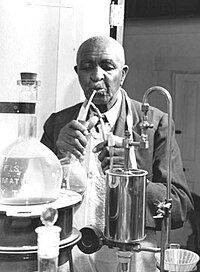 “Man cannot live by bread alone; he must have peanut butter.” What would we do without it? Dr. George Washington Carver, American scientist, botanist, educator, artist, and inventor discovered 325 products that could be made from the lowly peanut, which originally came from Africa.
“Man cannot live by bread alone; he must have peanut butter.” What would we do without it? Dr. George Washington Carver, American scientist, botanist, educator, artist, and inventor discovered 325 products that could be made from the lowly peanut, which originally came from Africa.Born a slave in Missouri, Carver persevered through many obstacles and became a well-educated and much admired contributor to the American way of life. His scientific discoveries dealing with plants had a significant impact on southern agriculture which continues today.
Peanuts, soybeans, and sweet potatoes were the primary objects of his study for several decades. He once said, “If you do the common things in life in an uncommon way, you will command the attention of the world.” And so, he did.
The products that he developed from the peanut included cream, buttermilk, instant coffee, face powder, printer’s ink, shampoo, dyes, soap and wood stain. Soon farmers were making more money from peanuts than they did from cotton or tobacco. It was nicknamed “goober” which came from its Congo language name, “nguba.”
Today, the uses of peanut butter itself include curing hiccups, removing gum from carpet, removing bug splatters from cars, fixing scratches on DVD’s and CD’s, removing gum from hair.
Carver’s work with sweet potatoes produced 118 products including flour, starch, tapioca, dyes, ink, and synthetic rubber. During World War I, sweet potato flour was mixed with wheat flour to make bread because wheat was in short supply.
 Soybeans had been brought from China and were first planted in Georgia in 1765 and primarily used for livestock feed. Carver found through his experimentation that it was a good source of protein and oil. He told farmers to rotate peanuts, soybeans, and sweet potatoes. The result was a better cotton crop because the plants replaced essential nutrients in the soil.
Soybeans had been brought from China and were first planted in Georgia in 1765 and primarily used for livestock feed. Carver found through his experimentation that it was a good source of protein and oil. He told farmers to rotate peanuts, soybeans, and sweet potatoes. The result was a better cotton crop because the plants replaced essential nutrients in the soil.Dr. Carver’s experimentation with soybeans resulted in the development of laminated plywood, particleboard, finger-jointed lumber; soy based wood adhesive, and carpet and upholstery products. Henry Ford collaborated with Carver to produce a plastic material that was then used in several parts of car manufacturing.
Currently, a process called transesterification removes the glycerin from the soybean and leaves soy biodiesel which is cleaner burning than petroleum based diesel, reduces particle emissions, is non-toxic, renewable, and environmentally friendly. Soy crayons, soy ink, soy lubricants, and soy hydraulic fluid are widely used.
Though Dr. Carver received lucrative offers from Ford and Thomas Edison, he stayed faithful to Tuskegee Institute for fifty years where he died in 1943. Congress declared January 5 as Dr. George Washington Carver Day in honor of his life achievements and contributions to society.
Dr. Carver’s impact on Albemarle agriculture is immeasurable. Today, all 100 counties of North Carolina grow soybeans, and Pasquotank is one of the top producers. Each year Elizabeth City hosts a Soybean Festival to share information about the useful plant.
(Source: Black Pioneers of Science and Invention by Louis Haber)
No comments:
Post a Comment